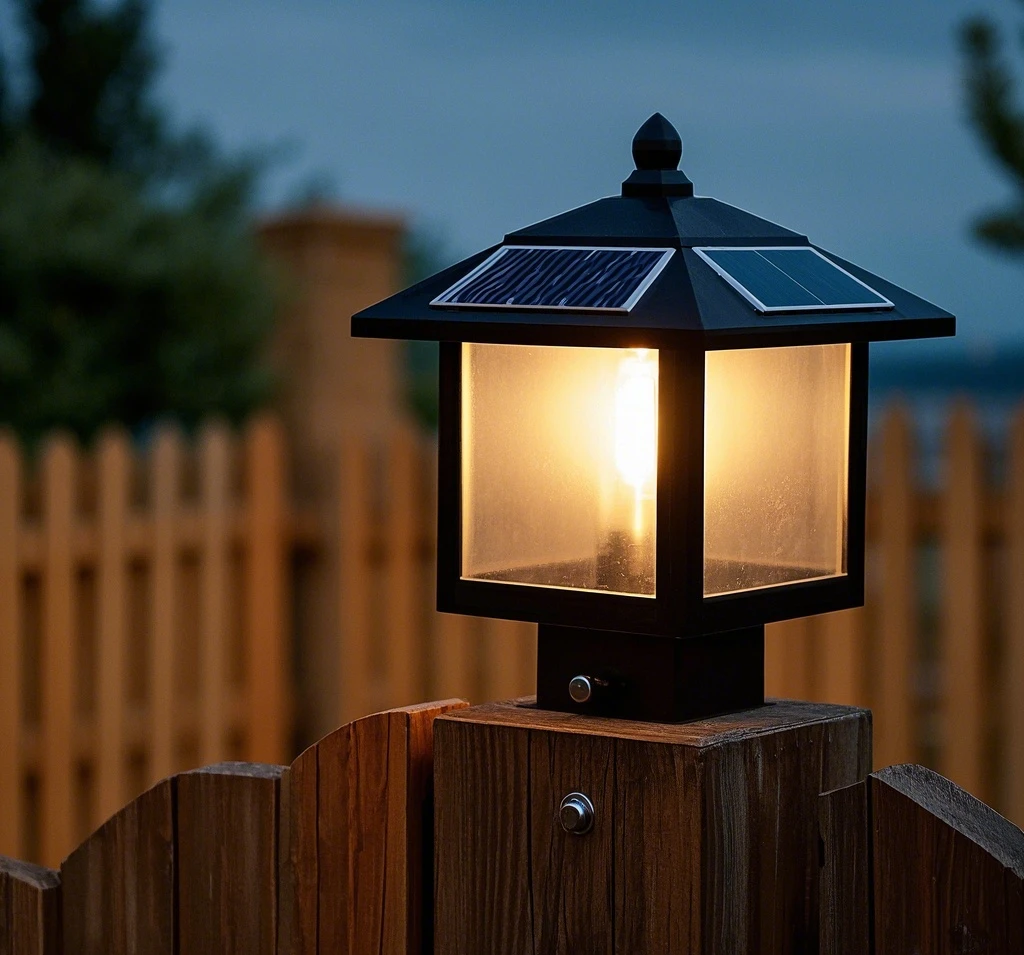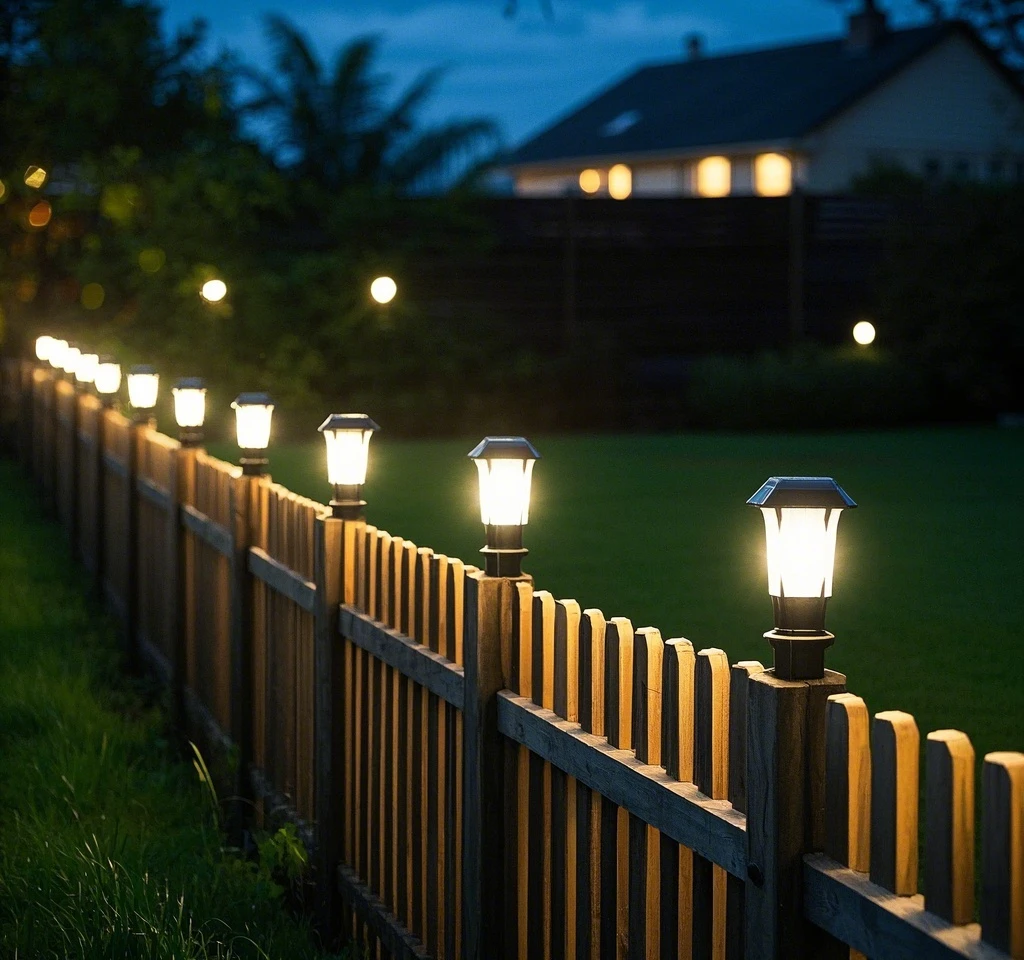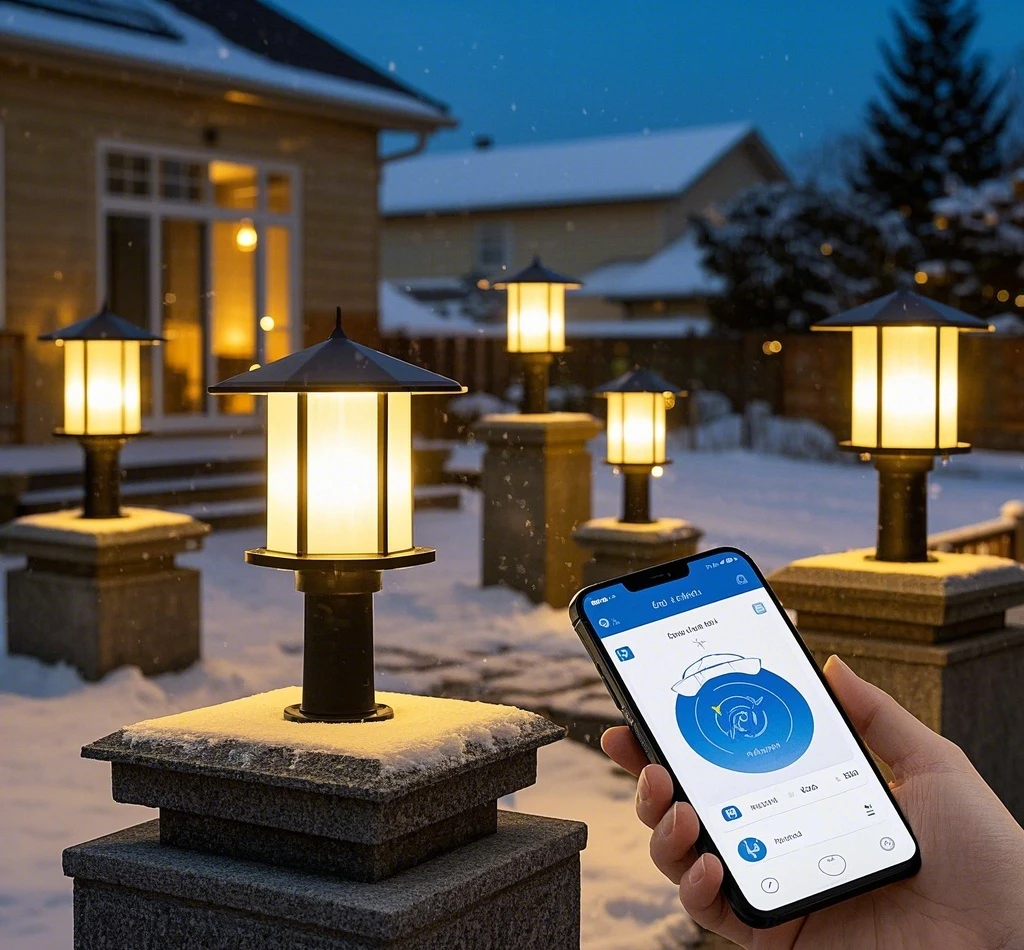As twilight settles, a gentle glow from fence lights softly illuminates your backyard, shielding your patio from neighbors’ glances while casting a warm sheen across the wooden slats. This delicate “light boundary” balances privacy lighting with boundary aesthetics, creating a welcoming yet private space. For North American homeowners in suburban neighborhoods or private backyards (typically 500-1000㎡), solar-powered fence lights offer an eco-friendly way to define property lines, enhance safety, and elevate visual appeal with minimal upkeep. This guide provides practical, design-driven strategies to deploy these lights, tailored to families seeking to protect their private spaces while maintaining a friendly ambiance, with specific parameters for easy implementation.

The Power of Light Boundaries: Privacy Meets Elegance
A fence is more than a barrier—it’s a canvas for expression. Solar-powered fence lights transform this canvas by softly marking boundaries, shielding indoor spaces from view, and adding aesthetic charm through light layering. Unlike harsh spotlights, these lights create a gentle, functional glow that enhances residential lighting. For example, the Carter family in Ohio installed perimeter lights along their backyard fence, noting that neighbors no longer peered into their patio, yet the warm glow fostered a neighborly vibe during evening gatherings. This guide outlines how to arrange fence lights for privacy, safety, and style, with maintenance tips to ensure durability in North America’s diverse climates.
1. Strategic Layout: Designing the Light Boundary
Effective placement of solar boundary lights hinges on height, spacing, and light color to achieve privacy lighting and boundary aesthetics. Below are key parameters for a typical 50-100ft fence line in a North American yard.
- Height Layers:
- Primary Lights (1.2-1.5m): Mount lights at 1.2-1.5m (4-5ft) to block sightlines into ground-level windows or patios, ensuring privacy. This height covers the fence’s upper half without spillover.
- Secondary Low Lights (0.6m): Install smaller, low-profile lights at 0.6m (2ft) to outline the fence base, enhancing boundary aesthetics by defining the ground edge.
- Checklist: Confirm primary lights shield key areas (e.g., living room windows) and low lights illuminate the base without ground glare.
- Spacing Rhythm:
- Space lights 1.5-2m (5-6.5ft) apart for even illumination without dense or sparse patches. For a 50ft fence, 8-10 primary lights and 10-12 low lights suffice.
- Example: A Texas homeowner spaced 10 fence lights 1.8m apart along a 60ft wooden fence, achieving seamless coverage with no dark gaps.
- Checklist: Walk the fence line at night to ensure no unlit sections exceed 2m, maintaining consistent privacy lighting.
- Mixed Light Strategy:
- Warm White (2700K-3000K): Use for primary lights (1.2-1.5m) to create a cozy, inviting glow that enhances boundary aesthetics and feels welcoming.
- Low-Brightness Cool White (4000K): Use for low lights (0.6m) at 50-100 lumens to subtly mark the boundary without overpowering the warm primary glow.
- Checklist: Ensure warm and cool lights blend smoothly, with no jarring color clashes (test at night for unified ambiance).
2. Privacy and Safety: Securing the Perimeter
Fence lights enhance privacy and safety by eliminating dark zones and controlling light intensity, ensuring a secure yet approachable boundary.
- Eliminating Blind Spots:
- Place lights at fence corners and gate sides, where shadows often form. For a standard backyard, install one primary light (1.2-1.5m) at each corner and two near gates for full coverage.
- Example: A Seattle family added perimeter lights at their gate posts, preventing stumbles on rainy nights and deterring unwanted visitors.
- Checklist: Confirm all corners and entry points are lit, with no shadows exceeding 1m in length.
- Brightness Control:
- Use 300-500 lumen lights for primary illumination, bright enough to outline the fence and deter intruders but not so intense as to penetrate slats or disturb neighbors.
- Low lights (50-100 lumens) at 0.6m ensure ground visibility without contributing to light pollution.
- Glare Control: Angle primary lights downward 10°-15° to focus on the fence surface, avoiding spillover into adjacent properties.
- Checklist: Measure light intensity beyond the fence (≤10lux) to ensure glare control and neighbor-friendly lighting.
- Motion Sensors:
- Select lights with motion sensors (10-15ft range) for gates or high-traffic areas, activating at full brightness only when needed to save energy.
- Example: A Florida homeowner’s motion-sensing fence lights activated during evening walks, enhancing security while cutting energy use by 40%.

3. Style Pairings: Matching Fence Aesthetics
Perimeter lights should complement the fence’s material and style, enhancing boundary aesthetics while blending with the yard’s character. Below are suggestions for common North American fence types.
- Wooden Fences (Rustic/Country Style):
- Design: Choose lights with wood-grain or bronze finishes to match the natural texture. Warm white (2700K) enhances the wood’s warmth.
- Example: A Vermont family used bronze-toned fence lights on their cedar fence, creating a cozy, farmhouse vibe that glowed softly at dusk.
- Checklist: Ensure light color matches wood tones (e.g., avoid cool white on warm cedar).
- Metal Fences (Modern/Industrial Style):
- Design: Opt for matte black or brushed silver lights with sleek, cylindrical shapes. Neutral white (3500K) complements metal’s clean lines.
- Example: A Chicago homeowner paired black perimeter lights with an aluminum fence, achieving a modern, urban look that crisply defined their yard.
- Checklist: Confirm lights don’t overpower the fence’s minimalist aesthetic (e.g., use 300lm max for primary lights).
- Minimalist Fences (Vinyl/Composite):
- Design: Select slim, no-frills lights in white or black to avoid distracting from the fence’s clean lines. Warm white (3000K) softens the look.
- Example: A California family used narrow fence lights on their white vinyl fence, maintaining a sleek, unobtrusive boundary glow.
- Checklist: Ensure lights are flush or low-profile to preserve the fence’s simplicity.
4. Maintenance and Durability: Weatherproofing for Longevity
Solar boundary lights must withstand North America’s varied climates—rainy Pacific Northwest, snowy Northeast, or humid Southeast—while requiring minimal upkeep.
- Weatherproofing:
- IP Rating: Choose IP65+ rated lights to resist rain, snow, and dust. IP67 models are ideal for coastal or high-precipitation areas.
- Materials: Select corrosion-resistant ABS plastic or aluminum alloy housings to prevent rust in humid climates (e.g., Florida’s salty air).
- Example: A Maine family’s IP66 fence lights survived two snowy winters without corrosion, unlike cheaper plastic models that cracked.
- Checklist: Verify seals on light housings to ensure weatherproof performance.
- Cleaning Routine:
- Wipe solar panels monthly with a damp cloth to remove leaves, dust, or snow, common in suburban yards. A 10-light setup takes ~5 minutes to clean.
- Clean lamp housings quarterly with a mild detergent to maintain clarity, especially for frosted lenses.
- Checklist: Ensure panels are unobstructed (e.g., trim overhanging branches) to maximize charging efficiency.
- Battery Maintenance:
- Use lights with replaceable 18650 lithium batteries, swapped every 1-2 years (~$5 per light). Standardizing battery types simplifies replacements.
- Example: A Colorado homeowner used one battery model across their perimeter lights, cutting maintenance time by 50% during replacements.
Conclusion: The Gentle Art of Light Boundaries
Solar-powered fence lights weave a delicate balance of privacy lighting and boundary aesthetics, transforming a functional fence into a nighttime centerpiece. By layering warm white primary lights at 1.2-1.5m with subtle cool white low lights at 0.6m, you create a soft yet secure perimeter that shields your backyard without isolating it. Whether it’s a wooden fence glowing with rustic charm, a sleek metal barrier defining a modern yard, or a minimalist vinyl fence with understated elegance, these lights adapt to your style while enduring North America’s weather. With minimal upkeep—monthly wipes and occasional battery swaps—solar boundary lights offer a lasting, eco-friendly solution. They’re not just lights; they’re a gentle boundary that whispers “home” while keeping the outside world at a warm, respectful distance.


Leave a Reply